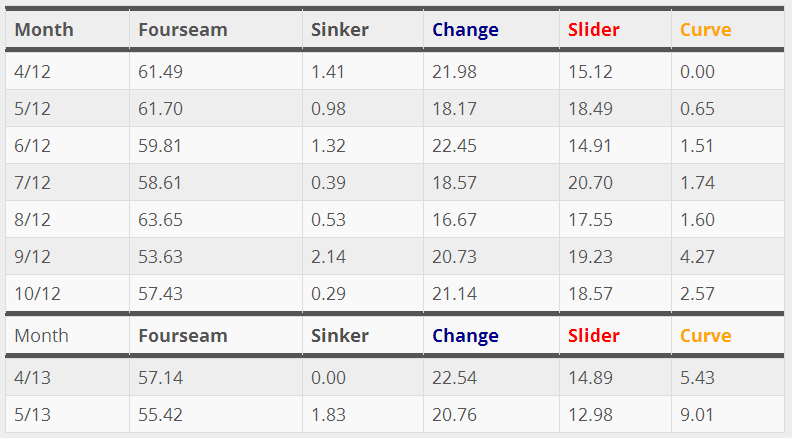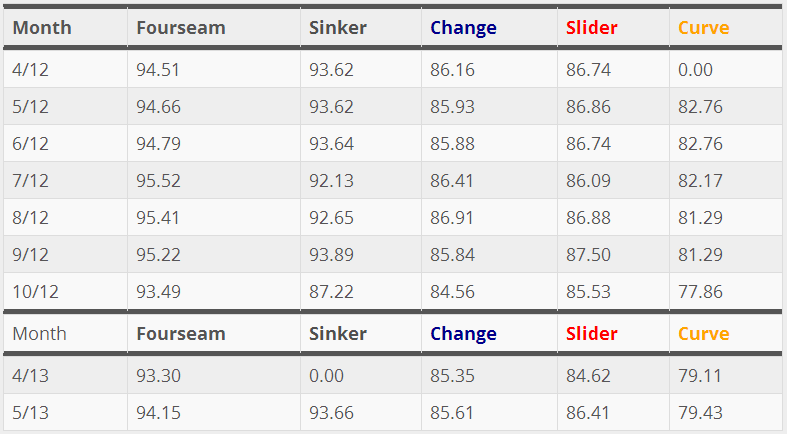A couple weeks back the Detroit Tigers and the Texas Rangers squared off in ESPN’s Sunday Night Baseball . You might recall this game because Miguel Cabrera went 4-4 with three home runs and five RBI, the first of four straight games with a HR.
During his time with the Tigers, Buster Olney sat down with Max Scherzer for an in-depth conversation. Much of the discussion was included in the May 20th edition of the ESPN Baseball Tonight podcast that Olney produces each week day.
Link to ESPN: Baseball Tonight with Buster Olney podcast
In the conversation Olney asked Scherzer about his curveball and here’s what Max had to say:
I’ve been tinkering with the curveball since last year, the second half. I’ve been trying to find a pitch that slows down everybody. It’s 15 mph off my fastball. I feel like everything else is kind of hard and it doesn’t change the hitters timing. I was able to throw it but the consistency on it wasn’t quite where it needed to be… By doing that it allows me to have a fourth pitch and a pitch that really slows down and disrupts the hitters timing. That pitch by itself can help play up every other pitch that I have.
~ Max Scherzer on 5/20/13 Baseball Tonight Podcast
There are a number of very interesting things buried in the comments. When hearing about Scherzer’s increased use of the curve ball, his ability to more effectively locate the pitch, and the timing problems it might create for hitters, I realized the opportunity to join these anecdotes with data analysis. If the data supports these comments, we could be looking at a pitcher with the ability to take a gigantic step forward.
1. I’ve Been Tinkering With The Curve Ball Since Last Year, The Second Half
This is true. In looking at Scherzer’s PITCH f/x data from April 2012 up to May 2013, there is a clear increase in the use of the curve. The table below, from Max’s “Usage and Outcomes” section of his Player Card at BrooksBaseball.net, shows that he has added a new pitch. In April 2012 he didn’t throw the curveball at all, and he has gradually increased usage of the pitch to the point where he threw it nine percent of the time in May 2013.

2. It’s 15 MPH Off My Fastball
Switching now to the “Velo and Movement” data at Brooks Baseball, a quick glance at the data shows that Max has been decreasing the velocity on the curve, allowing him to increase the velocity differential from the fastball.

To focus in on just the fourseam and the curve, I put that data into its own table and calculated a difference column below. So Scherzer’s new pitch is roughly a 14-15 mph difference off the fastball. And this gives him a greater velocity differential from his changeup, which you can see from above, was previously his slowest pitch. The curveball is about 6-7 mph slower than that pitch.
| Month | FS Velocity | CV Velocity | Difference |
|---|---|---|---|
| 5/12 | 94.66 | 82.76 | 11.90 |
| 6/12 | 94.79 | 82.76 | 12.03 |
| 7/12 | 95.52 | 82.17 | 13.35 |
| 8/12 | 95.41 | 81.29 | 14.12 |
| 9/12 | 95.22 | 81.29 | 13.93 |
| 10/12 | 93.49 | 77.86 | 15.63 |
| 4/13 | 93.30 | 79.11 | 14.19 |
| 5/13 | 94.15 | 79.43 | 14.72 |
3. I Was Able To Throw It But The Consistency Wasn’t Where It Needed To Be
I interpret this to mean Scherzer had a hard time keeping the curveball near the strike zone. While researching this assertion, it jumped out at me just how infrequently the curve ball has been used in the past. When you look at the actual pitch count, you can really see that this has been an experimental pitch until recently. And now Scherzer is really starting to use it as a consistent part of the repertoire as he gains confidence in the pitch.
| Month | Ball% | Strike% | Foul | BIP | Count |
|---|---|---|---|---|---|
| 5/12 | 25.00% | 50.00% | 0.00% | 25.00% | 4 |
| 6/12 | 25.00% | 37.50% | 25.00% | 12.50% | 8 |
| 7/12 | 22.22% | 33.33% | 22.22% | 22.22% | 9 |
| 8/12 | 22.22% | 22.22% | 44.44% | 11.11% | 9 |
| 9/12 | 50.00% | 5.00% | 20.00% | 25.00% | 20 |
| 10/12 | 55.56% | 0.00% | 22.22% | 22.22% | 9 |
| 4/13 | 51.85% | 25.93% | 14.81% | 7.41% | 27 |
| 5/13 | 33.90% | 33.90% | 15.25% | 16.95% | 59 |
For comparison purposes, here are the pitch outcomes of Scherzer’s fastball throughout his career:
| Month | Ball% | Strike% | Foul | BIP | Count |
|---|---|---|---|---|---|
| Career | 34.24% | 29.92% | 21.23% | 14.02% | 9,917 |
Granted, 59 pitches in May is small potatoes compared to nearly 10,000 fastballs thrown in his career, but last month Scherzer was able to throw his curve for a strike as frequently as he’s been able to throw his fastball for a strike throughout his career. He’s definitely found a greater level of consistency with the pitch.
Conclusion
It is true that Max Scherzer has added a new pitch. It does give him greater speed differential from his fastball than any of his other pitches. He has demonstrated the ability to throw it consistently for a strike (for one month at least). His K/BB rate is on a sharp upward trend (and has been even before he added this pitch. According to FIP (2.45) and xFIP (2.78), he’s been unlucky thus far (3.42 ERA).
He’s potentially entering elite status. On top of his normal career progression, the curveball could help him get there.
Until next time. Stay smart.






